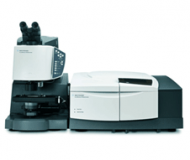Spectroscopy
Analysis of the composition of a material often involves a range of spectroscopic techniques to determine molecular and chemical composition. Only by leveraging all of these techniques can a reliable determination of composition be made.
Spectroscopy Techniques
- Standard FTIR
- UV/Vis Spectroscopic Analysis in Reflection or Transmission
- ATR (crystal contact and flow cell)
- Gas Flow Analysis
- 2D Mapping
- TGA-FTIR - Allowing quantification of mass loss due to evaporation or combustion with simultaneous identification of the evolved species with FTIR
- Elemental Analysis using Electron Dispersive Spectroscopy to obtain maps of elemental distribution and composition
- X-ray Photoelectron Spectroscopy (XPS or ESCA)
- Inductively Coupled Plasma Spectroscopy (ICP)
- Auger Spectroscopy
- Raman Spectroscopy
- Gas Chromatography with Mass Spectrometry (GCMS)
- Electron Spin Resonance Spectroscopy (ESR or EPR)
Our state of the art instruments are regularly calibrated or verified against NIST standards. We can examine solids, liquids and anything in between. Email us for a free spectroscopy quote.
Relevant ASTM standards performed
- D7083 Standard Practice for Determination of Monomeric Plasticizers in Poly (Vinyl Chloride) (PVC) by Gas Chromatography
- D3465 Standard Test Method for Purity of Monomeric Plasticizers by Gas Chromatography
- D4275 Standard Test Method for Determination of Butylated Hydroxy Toluene (BHT) in Polymers of Ethylene and Ethylene–Vinyl Acetate (EVA) Copolymers By Gas Chromatography
- D5508 Standard Test Method for Determination of Residual Acrylonitrile Monomer in Styrene Acrylonitrile Copolymer Resins and Nitrile Butadiene Rubber by Headspace Capillary Gas Chromatography (HS CGC)
- D4526 Standard Practice for determination of Volatiles in Polymers by Static Headspace Gas Chromatography
